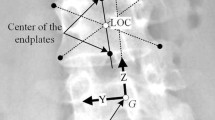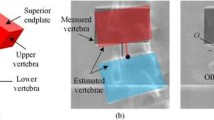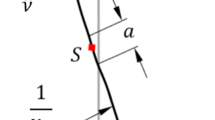Abstract
The flexibility of the scoliotic spine is an important biomechanical parameter to take into account in the planning of surgical instrumentation. The objective of the paper was to develop a method to characterisein vivo the mechanical properties of the scoliotic spine using a flexible multi-body model. Vertebrae were represented as rigid bodies, and intervertebral elements were defined at every level using a spherical joint and three torsion springs. The initial mechanical properties of motion segments were defined fromin vitro experimental data reported in the literature. They were adjusted using an optimisation algorithm to reduce the discrepancy between the simulated and the measured Ferguson angles in lateral bending of three spine segments (major or compensatory left thoracic, right thoracic and left lumbar scoliosis curves). The flexural rigidity of the spine segments was defined in three categories (flexible, nominal, rigid) according to the estimated mechanical factors (α). This approach was applied with ten scoliotic patients under-going spinal correction. Personalisation of the model resulted in an increase of the initial flexural rigidity for seven of the ten lumbar segments (1.38≤α≤10.0) and four of the ten right thoracic segments (1.74≤α≤5.18). The adjustment of the mechanical parameters based on the lateral bending tests improved the model's ability to predict the spine shape change described by the Ferguson angles by up to 50%. The largest differences after personalisation were for the left lumbar segments in left bending (40±30). Thein vivo identification of the mechanical properties of the scoliotic spine will improve the ability of biomechanical models adequately to predict the surgical correction, which should help clinicians in the planning of surgical instrumentation manoeuvres.
Similar content being viewed by others
References
Adams, M. A. (1995): ‘Mechanical testing of the spine. An appraisal of methodology, results, and conclusions’,Spine,20, pp. 2151–2156
Aronsson, D. D., Stokes, I. A., Ronchetti, P. J., andRichards, B. S. (1996): ‘Surgical correction of vertebral axial rotation in adolescent idiopathic scoliosis: prediction by lateral bending films’,J. Spinal Disord.,9, pp. 214–219
Aubin, C. É., Descrimes, J. L., Dansereau, J., Skalli, W., Lavaste, F., andLabelle, H. (1995): ‘Geometrical modeling of the spine and the thorax for the biomechanical analysis of scoliotic deformities using the finite element method (in French)’,Ann. Chir.,49, pp. 749–761
Aubin, C. É., Petit, Y., Stokes, I. A. F., Poulin, F., andGardner-Morse, M. (2003): ‘Biomechanical modeling of posterior instrumentation of the scoliotic spine’,Comput. Methods Biomech. Biomed. Eng.,6, pp. 27–32
Cheriet, F., Dansereau, J., Petit, Y., Aubin, C. É., Labelle, H., andDe Guise, J. A. (1999): ‘Towards the self-calibration of a multi-view radiographic imaging system for the 3D reconstruction of the human spine and rib cage’,Int. J. Pattern Recognit. Artif. Intell.,13, pp. 761–779
Cheung, K. M., andLuk, K. D. (1997): ‘Prediction of correction of scoliosis with use of the fulcrum bending radiograph’J. Bone Joint Surg. Am.,79, pp. 1144–1150
Cripton, P. A., Bruehlmann, S. B., Orr, T. E., Oxland, T. R., andNolte, L. P. (2000): ‘In vitro axial preload application during spine flexibility testing: towards reduced apparatus-related artefacts’,J. Biomech.,33, pp. 1559–1568
Gardner-Morse, M., andStokes, I. A. (1994): ‘Three-dimensional simulations of the scoliosis derotation maneuver with Cotrel-Dubousset instrumentation’,J. Biomech.,27, pp. 177–181
Ghista, D. N., Viviani, G. R., Subbaraj, K., Lozada, P. J., Srinivasan, T. M., andBarnes, G. (1988): ‘Biomechanical basis of optimal scoliosis surgical correction’,J. Biomech.,21, pp. 77–88
Klepps, S. J., Lenke, L. G., Bridwell, K. H., Bassett, G. S., andWhorton, J. (2001): ‘Prospective comparison of flexibility radiographs in adolescent idiopathic scoliosis’,Spine,26, pp. E74-E79
Leborgne, P., Skalli, W., Lecire, C., Dubousset, J., Zeller, R., andLavaste, F. (1999): ‘Simulations of CD surgery on a personalized finite element model: preliminary results’, in ‘Research into spinal deformities 2’ (IOS Press, Amsterdam, 1999), pp. 126–129
Matsumoto, T., Kitahara, H., Minami, S., Takahashi, K., Yamagata, M., Moriya, H., andTamaki, T. (1997): ‘Flexibility in the scoliotic spine: three-dimensional analysis’,J. Spinal Disord.,10, pp. 125–131
Moe, J., Winter, R., Bradford, D., andLonstein, J. (1978): ‘Scoliosis and other spinal deformities’, (W. B. Saunders Co. Philadelphia, 1978)
Oxland, T. R., Lin, R. M., andPanjabi, M. M. (1992): ‘Three-dimensional mechanical properties of the thoracolumbar junction’,J. Orthop. Res.,10, pp. 573–580
Panjabi, M. M., Brand, R. A. Jr., andWhite, A. A. III. (1976a): ‘Three-dimensional flexibility and stiffness properties of the human thoracic spine’,J. Biomech.,9, pp. 185–192
Panjabi, M. M., Brand, R. A. Jr., andWhite, A. A. III. (1976b): ‘Mechanical properties of the human thoracic spine as shown by three-dimensional load-displacement curves’,J. Bone Joint Surg. Am.,58, pp. 642–652
Panjabi, M. M., Oxland, T. R., Yamamoto, I., andCrisco, J. J. (1994): ‘Mechanical behavior of the human lumbar and lumbosacral spine as shown by three-dimensional load-displacement curves’,J. Bone Joint Surg. Am.,76 pp. 413–424
Patwardhan, A. G., Havey, R. M., Meade, K. P., Lee, B., andDunlap, B. (1999): ‘A follower load increases the load-carrying capacity of the lumbar spine in compression’,Spine,24, pp. 1003–1009
Perdriolle, R. (1979): ‘La scoliose: son étude tridimensionnelle’ (Maloine S.A., Paris, 1979)
Petit, Y., Aubin, C. É., andLabelle, H. (2003): ‘Spinal shape changes resulting from scoliotic spine surgical instrumentation expressed as intervertebral rotations and centers of rotation’,J. Biomech. (accepted for publication)
Polly, D. W. Jr., andSturm, P. F. (1998): ‘Traction versus supine side bending. Which technique best determines curve flexibility?’,Spine,23, pp. 804–808
Poulin, F., Aubin, C. É., Stokes, I. A., Gardner-Morse, M., andLabelle, H. (1998): ‘Bromechanical modeling of instrumentation for the scoliotic spine using flexible elements: a feasibility study (in French)’,Ann. Chir.,52, pp. 761–767
Sevastik, J. A., andStokes, I. A. F. (2000): ‘Idiopathic scolios terminology’, in ‘SPINE: State of the art reviews’ (Philadelphia, 2000), pp 299–303
SRS Working Group on Spinal Classification Nomenclature (2003): ‘SRS glossary of scoliosis terms’, http://www.srs. org/htm/glossary/nomenclature.htm
Stokes, I. A., Aronson, D. D., Ronchetti, P. J., Labelle, H., andDansereau, J. (1993): ‘Reexamination of the Cobb and Ferguson angles: bigger is not always better’,J. Spinal Disord.,6, pp. 333–338
Stokes, I. A. F., Gardner-Morse, M., Aubin, C. É., Poulin, F., andLabelle, H. (1999): ‘Biomechanical simulations for planning of scoliosis surgery’, in ‘Research into spinal deformities 2’ (IOS Press, Amsterdam, 1999),59, pp. 343–346
Vanderby, R., Daniele, M., Patwardhan, A., andBunch, W. (1986): ‘A method for the identification of in-vivo segmental stiffness properties of the spine’,J. Biomech. Eng.,108, pp. 312–316
Author information
Authors and Affiliations
Rights and permissions
About this article
Cite this article
Petit, Y., Aubin, C.É. & Labelle, H. Patient-specific mechanical properties of a flexible multi-body model of the scoliotic spine. Med. Biol. Eng. Comput. 42, 55–60 (2004). https://doi.org/10.1007/BF02351011
Received:
Accepted:
Issue Date:
DOI: https://doi.org/10.1007/BF02351011




